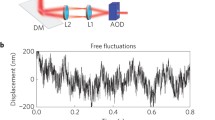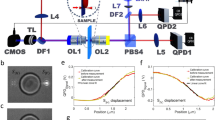Abstract
Frequency analysis of thermally excited surface undulations of erythrocytes leading to the flicker phenomenon is applied to determine biochemically and physically induced modulations of the membrane curvature elasticity. Flicker spectra of individual cells fixed to the window of a flow chamber by polylysine are taken by phase contrast microscopy, enabling investigations of the reversibility of the structural modifications. The spectra may be approximated by Lorentzian lines in most cases. By measuring the amplitude (at zero frequency) and the line width, effects of the structural changes on the curvature elastic constant, K c , and the wavelength distribution of the undulations may be studied separately.
Effect of physically induced modifications: The temperature dependence of the flicker spectra are taken from 10°C to 37°C. Above 20°C, K c decreases with increasing temperature whereas the reverse holds below this limit. The latter anomalous behaviour is explained in terms of a conformational change associated with protein and lipid lateral phase separation. The bending stiffness increases when the cells swell osmotically, owing to surface tension effects. The dependence of the flicker spectra on the viscosity of the suspension medium agrees with the theoretical prediction.
Biochemically and drug induced modifications: 5 vol‰ of ethanol leads to a pronounced and reversible suppression of the long wavelength undulations without altering the discoid cell shape and without affecting the bending stiffness appreciably. Adsorption of dextran to the glycocalix increases K c by a factor of 1.6 at saturation. The bending stiffness is increased by a factor of 1.3 after cross-linking the proteins with the SH-oxidizing agent diamid. Injection of Ca++ into the cell via ionophores evokes (within 10 min) the formation of fine — probably spectrin free — spicules. This leads to an increase in K c by a factor of 1.3 which is explained in terms of a lateral condensation of the spectrin/actin network. The spicule formation and K c change is completely reversible (within 2 min) after perfusion with Ca++-free buffer. Cholesterol depletion leads first to a continuous increase in K c without change of the cell shape whereas a sudden discocyte- to echinocyte transformation sets in below a critical steroid content. The latter transition is also observed in cell suspensions and is reminiscent of a phase transition. The anti-tumor drug actinomycin D evokes an increase in the bending stiffness K c by a factor of two, suggesting that its effect is at least partially due to a modulation of the membrane structure. The α-receptor agonist leads to a remarkable increase in K c (by about 25%) at 10-4 M but the effect is not reversed by the α-antagonist prazosin, suggesting that the agonist exerts a non-specific effect.
A new technique, dynamic reflection interference contrast microscopy, is introduced by which absolute values of the amplitudes of the surface undulations and therefore K c can be determined. The value obtained: K c =5·10-13 erg is about a factor of two larger then the bending stiffness of pure lipid bilayers. We suggest that the surface undulations may also be determined by lateral fluctuations of the quasi-two-dimensional spectrin/actin network.
Similar content being viewed by others
References
Beck K, Bereiter-Hahn J (1981) Evaluation of reflection interference contrast microscope images of living cells. Microsc Acta 84:153–178
Bessis M (1973) Living red blood cells and their ultrastructure. Springer, Berlin Heidelberg New York
Bessis M, Mohandas N (1985) A diffractometric method for the measurement of cellular deformability. Blood Cells 1:307–313
Brochard F, Lennon JF (1975) Frequency spectrum of the flicker phenomenon in erythrocytes. J Phys (Paris) 36:1035–1047
Chabanel A, Flamm M, Shung KLP, Lee MM, Schachter D, Chien S (1983) Influence of cholesterol content on red blood cell membrane viscoelasticity and fluidity. Biophys J 44:171–178
Chailley B, Girand F, Claret M (1981) Alterations in human erythrocyte shape and the state of spectrin and phospholipid phosphorylation induced by cholesterol depletion. Biochim Biophys Acta 643:636–641
Duwe HP (1985) Analyse thermisch angeregter Oberflächenwellen zur Bestimmung des Elastizitätsmoduls von Membranen durch Bildverarbeitung. Diploma Thesis Munich 1985
Elgsaeter A, Shotton DM, Branton D (1976) Intromembrane particle aggregation in erythrocyte ghosts. II. The influence of spectrin aggregation. Biochim Biophys Acta 426:101–122
Engelhardt H, Duwe HP, Sackmann E (1985) Bilayer bending clasticity measured by Fourier analysis of thermally excited surface undulations of flaccid vesicles. J Phys Lett (Paris) 46:L395-L400
Evans AE, Skalak R (1980) Mechanics and thermodynamics of biomembranes. CRC Press, Boca Raton, Fl, USA
Fischer TM, Stöhr-Liesen M, Schmidt-Schönbein H (1978) The red cells as a fluid droplet: tank thread-like motion of the human erythrocyte membrane in shear flow. Science 202:894–896
Fricke K, Sackmann E (1984) Variation of frequency spectrum of the erythrocyte flickering caused by aging, osmolarity, temperature and pathological changes. Biochim Biophys Acta 803:145–152
Fung YCF (1981) Biomechanics: Mechanical properties of living tissues. Springer, New York Heidelberg Berlin
Galla HJ, Luisetti J (1980) Lateral and transversal diffusion and phase transformation of erythrocyte membranes: an excimer fluorescence study. Biochim Biophys Acta 596:108–117
Gaub H, Engelhardt H, Sackmann E (1984) Viscoelastic properties of erythrocyte membranes in high frequency electric fields. Nature 307:378–380
Gennes PG de (1981) Polymer solutions near an interface. —Adsorption and deplation layers. J Phys (Paris) 14:1637–1644
Glaser R, Herrmann A (1980) The sedimentation velocity of individual human erythrocytes as a function of temperature. Biorheology 17:289–291
Haest CWM, Fischer TM, Plasa G, Deuticke B (1980) Stabilization of erythrocyte shape by a chemical increase in membrane shear stiffness. Blood Cells 6:539–553
Kapitza HG, Sackmann E (1982) Local measurement of lateral motion in erythrocyte membranes by photobleaching technique. Biochim Biophys Acta 595:56–59
Kwok R, Evans E (1981) Thermoelasticity of large lecithin bilayer vesicles. Biophys J 35:637–652
Lange Y, Cutler HB, Steck TL (1980) The effect of cholesterol and other intercalated amphiphaths on the countour and stability of the isolated red cell membrane. J Biol Chem 255:9331–9337
Lutz HU, Shih-Chun Liu, Palek J (1977) Release of spectrin free vesicles from human erythrocytes during ATP depletion. J Cell Biol 73:548–559
Owen J, Deeley T, Coakley WT (1983) Interfacial instability and membranes internalization in human erythrocytes heated in the presence of serum albumine. Biochim Biophys Acta 727:293–302
Petrov AG, Bivas J (1984) Elastic and flexoelectric aspects of out-of-plane fluctuations in biological and model membranes. Prog Surg Sci 16:389–512
Sackmann E, Engelhardt H, Fricke K, Gaub H (1984) On dynamic molecular and elastic properties of lipid bilayers and biological membranes. Colloids Surf 10:321–335
Schindler M, Koppel DE, Sheetz MP (1980) Modulation of membrane protein lateral mobility by polyphosphates and polyamines. Proc Natl Acad Sci USA 7:1457–1461
Schneider MB, Jenkins JT, Webb WW (1984) Thermal fluctuations of large quasi-spherical bimolecular phospholipid vesicles. J Phys (Paris) 5:1457–1472
Sinha B, Chignell CF (1979) Interaction of antitumor drugs with human erythrocyte ghost membranes and mastocytoma P 815: A spin label study. Biochem Biophys Res Commun 86:1051–1057
Svetina S, Zeks B (1983) Bilayer coupling hypothesis of red cell shape transformations and osmotic hemolysis. Biomed Biochim Acta 42:86–90
Author information
Authors and Affiliations
Rights and permissions
About this article
Cite this article
Fricke, K., Wirthensohn, K., Laxhuber, R. et al. Flicker spectroscopy of erythrocytes. Eur Biophys J 14, 67–81 (1986). https://doi.org/10.1007/BF00263063
Received:
Accepted:
Issue Date:
DOI: https://doi.org/10.1007/BF00263063




